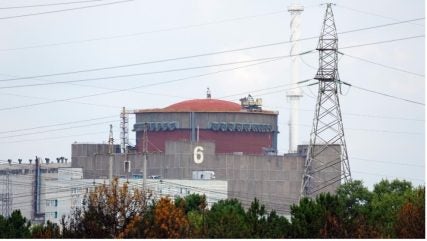
The International Atomic Energy Agency (IAEA) in its latest update said the Zaporizhia NPP (ZNPP) had temporarily lost the connection to its sole remaining 750 kilovolt (kV) off-site power line due to a reported short-circuit, leaving it reliant on a single back-up line for more than three hours. “The disconnection of the 750kV Dniprovksa line once again underlines the extremely precarious nuclear safety and security situation at the ZNPP during the armed conflict,” IAEA noted.
It occurred some six kilometres away from the ZNPP’s 750 kV open switchyard, in Russian-controlled territory. The ZNPP informed the IAEA experts stationed at the site that it was caused by a short-circuit, without providing further details.
The event also amplifies concerns around attacks on the electrical power infrastructure elsewhere in Ukraine, as indicated last week, highlighting the risk to the ZNPP as well to the other operating nuclear power plants (NPPs). When the 750 kV line was disconnected, the ZNPP received external electricity from its only 330 kV back-up line. Before the conflict, the plant had four 750 kV and six 330 kV lines available.
“For Europe’s largest nuclear power plant to depend on one or two power lines is a deep source of concern and clearly not sustainable. Our concerns also extend to the operating NPPs across Ukraine, where a disruption to off-site power supplies could have very serious implications for nuclear safety,” said IAEA Director General Rafael Mariano Grossi.
Earlier ZNPP also informed the IAEA of a drone attack on a transport workshop in the nearby industrial area, reportedly causing some damage but no casualties. If confirmed, this strike, around four kilometres from the ZNPP site, would further underline the continuing military-related risks facing this major nuclear facility, following last month’s drone attacks targeting the site itself, Grossi noted.
ZNPP said a civil communications network antenna was damaged in the attack at the transport workshop, where buses used for transporting plant personnel to the nearby town of Enerhodar are kept. In addition, the IAEA team of experts stationed at the ZNPP have continued to hear explosions at various distances from the plant over the past week.
“For the outside world, the situation at the ZNPP may have appeared relatively calm in recent weeks, since the drone attacks on the site confirmed by our experts in mid-April. But this is not the way we see the situation on the ground. The stark reality is one of constant danger. The nuclear safety and security situation at the site remains extremely vulnerable,” Grossi said.
The IAEA team of experts has continued to carry out walkdowns across the site, visiting the reactor building and safety systems rooms of unit 3, where they observed key equipment including steam generators and a main cooling pump, as well as a planned change of the duty spent fuel pool pump.
The team did not observe any boron deposits but noted a small water leak from the ventilation system piping, which the ZNPP stated would be serviced as part of planned upcoming maintenance. The team also visited the turbine hall of unit 3, where they were able to observe some of the equipment but were – once again – not granted access to the western side of the hall.
The IAEA experts are continuing to monitor the maintenance activities at the ZNPP, which are crucial for long-term nuclear safety and security, as the Director General has repeatedly emphasized.
Maintenance work on part of the safety systems of unit 1 resumed, after it was postponed in March, as previously reported. Electrical maintenance activities on the unit 2 main transformer as well as on one of the plant’s backup power transformers, began this week. The cleaning of one of the sprinkler ponds, which supplies water for the cooling of unit 6 and its safety systems has been completed while the cleaning of a unit 5 sprinkler pond is expected to finish shortly.
In addition, the IAEA team observed the successful performance of routine testing of an emergency diesel generator for unit 1, activities that need to be carried out regularly, especially in view of the site’s fragile off-site power situation.
With all six reactor units in cold shutdown – and therefore no longer generating heat or steam – the ZNPP informed the IAEA team that it had, once again, put two of the nine mobile diesel boilers back in operation to generate hot water for the site’s own needs.
In addition, the IAEA experts visited the ZNPP training centre where they observed main control room staff undergoing training on the full-scope simulators, while also having some discussions on the training of personnel.
Also this week, the team went to the site’s main warehouse facility, located outside of the ZNPP perimeter, to examine a range of electrical spare parts including small and medium sized transformers and electrical control cabinets, as well as larger electrical and mechanical equipment, all stored properly and in good condition.
However, the team noted that much of the electrical equipment originated from western suppliers and was delivered prior to the start of the armed conflict. The ZNPP representative explained that the transition to a new software system for managing spare parts is almost complete and that the plant is now able to publish tenders for the procurement of new spare parts and equipment from potential suppliers in the Russian Federation.





